warning SKODA SUPERB 2009 2.G / (B6/3T) Owner's Manual
[x] Cancel search | Manufacturer: SKODA, Model Year: 2009, Model line: SUPERB, Model: SKODA SUPERB 2009 2.G / (B6/3T)Pages: 294, PDF Size: 21.33 MB
Page 242 of 294
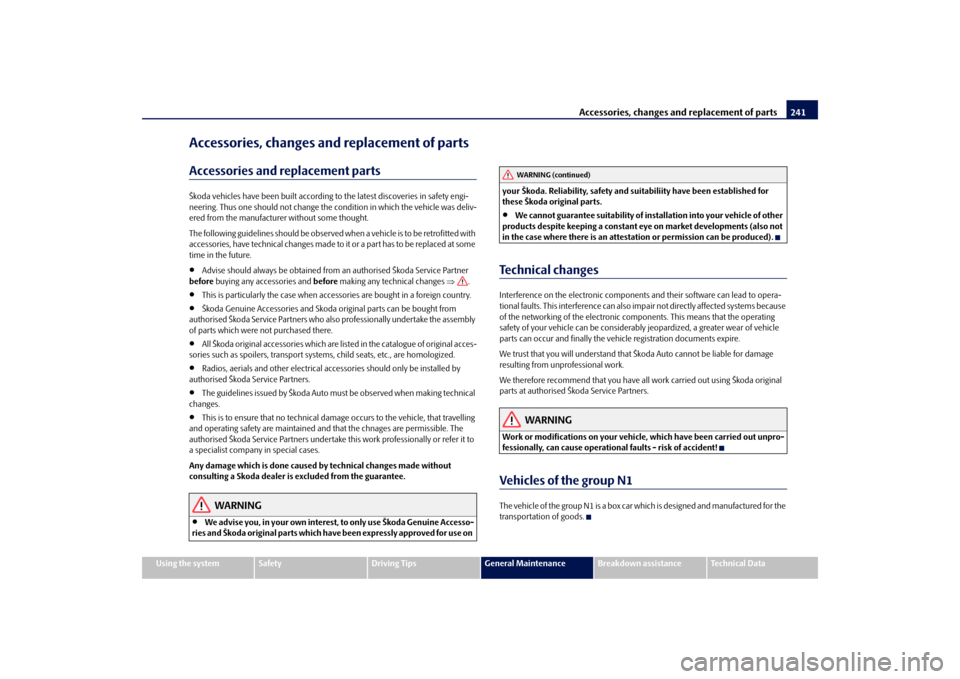
Accessories, changes and
replacement of parts
241
Using the system
Safety
Driving Tips
General Maintenance
Breakdown assistance
Technical Data
Accessories, changes and replacement of partsAccessories and replacement partsŠkoda vehicles have been bu
ilt according to the latest discoveries in safety engi-
neering. Thus one should no
t change the condition in which the vehicle was deliv-
ered from the manufacturer without some thought. The following guidelines should be observed when a vehicle is to be retrofitted with accessories, have technical ch
anges made to it or a par t has to be replaced at some
time in the future.•
Advise should always be obtained from an authorised Škoda Service Partner
before
buying any accessories and
before
making any technical changes
⇒
.
•
This is particularly the case when acce
ssories are bought in a foreign country.
•
Škoda Genuine Accessories and Skoda or
iginal parts can be bought from
authorised Škoda Service Partners who also professionally undertake the assembly of parts which were not purchased there.•
All Škoda original accessories which are listed in the catalogue of original acces-
sories such as spoilers, transport systems, child seats, etc., are homologized.•
Radios, aerials and other electrical accessories should only be installed by
authorised Škoda Service Partners.•
The guidelines issued by Škoda Auto must be observed when making technical
changes.•
This is to ensure that no technical damage
occurs to the vehicle, that travelling
and operating safety are maintained and that the chnages are permissible. The authorised Škoda Service Partners undertake this work professionally or refer it to a specialist company in special cases. Any damage which is done caused by technical changes made without consulting a Skoda dealer is
excluded from the guarantee.
WARNING
•
We advise you, in your own interest, to only use Škoda Genuine Accesso-
ries and Škoda original parts which have
been expressly approved for use on
your Škoda. Reliability, safety and su
itabiliity have been established for
these Škoda original parts.•
We cannot guarantee suitability of installation into your vehicle of other
products despite keeping a constant ey
e on market developments (also not
in the case where there is an attestation or permission can be produced).Technical changesInterference on the electronic components and their software can lead to opera-tional faults. This interference can also impair not directly affected systems because of the networking of the electronic co
mponents. This means that the operating
safety of your vehicle can
be considerably jeopardized,
a greater wear of vehicle
parts can occur and finally the vehi
cle registration documents expire.
We trust that you will understand that
Škoda Auto cannot be liable for damage
resulting from unprofessional work. We therefore recommend that you have all work carried out using Škoda original parts at authorised Škoda Service Partners.
WARNING
Work or modifications on your vehicle, which have been carried out unpro-fessionally, can cause operational faults - risk of accident!Vehicles of the group N1The vehicle of the group N1 is a box car wh
ich is designed and manufactured for the
transportation of goods.
WARNING (continued)
s2dk.1.book Page 241 Wednesday, April 8, 2009 12:23 PM
Page 244 of 294

Breakdown assistance
243
Using the system
Safety
Driving Tips
General Maintenance
Breakdown assistance
Technical Data
Breakdown assistanceBreakdown assistanceFirst-aid box*First-aid box The compartment for stowing the first-aid bo
x is located in the right of the luggage
compartment
⇒fig. 213
.
Note
Pay attention to the use-by-date of the contents of the first-aid box.
Warning triangleThe warning triangle can be attached to the
trim panel of the rear wall with rubber
straps
⇒fig. 214
.
Fire extinguisher*The fire extinguisher is attached with straps in a holder under the driver seat. Please read carefully the
instructions which are atta
ched to the fire extin-
guisher. The fire extinguisher must be checked by an authorised person or company annu- ally (please observe the differing legal requirements).
Fig. 213 Compartment for stowing first-aid box
Fig. 214 Placing of the warning triangle
s2dk.1.book Page 243 Wednesday, April 8, 2009 12:23 PM
Page 245 of 294
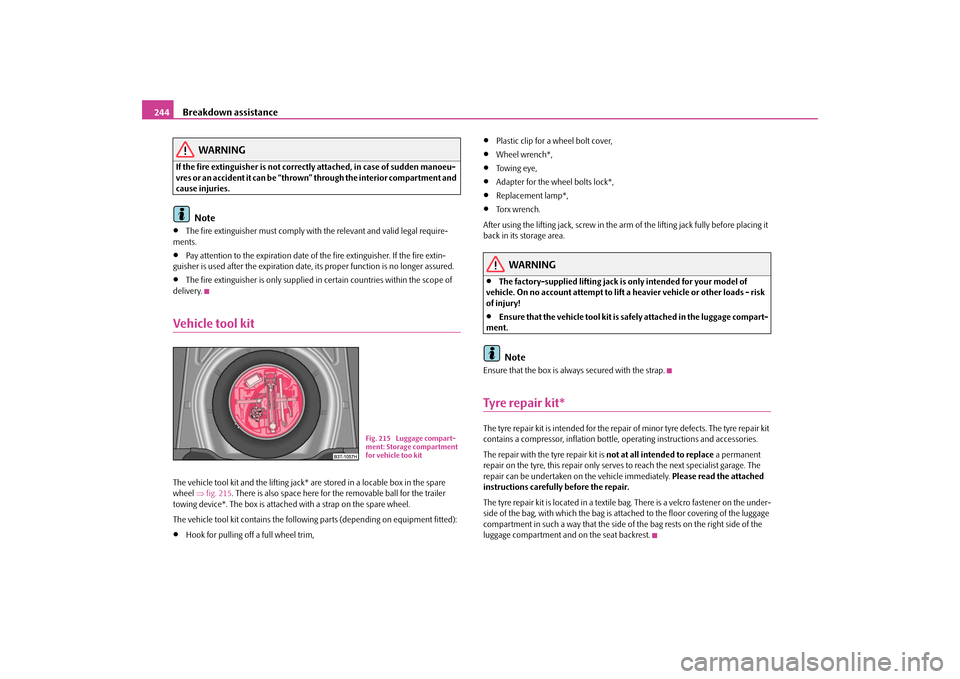
Breakdown assistance
244
WARNING
If the fire extinguisher is not correc
tly attached, in case of sudden manoeu-
vres or an accident it can be “thrown” through the interior compartment and cause injuries.
Note
•
The fire extinguisher must comply with
the relevant and valid legal require-
ments.•
Pay attention to the expiration date of the fire extinguisher. If the fire extin-
guisher is used after the expiration date,
its proper function is
no longer assured.
•
The fire extinguisher is only supplied in
certain countries within the scope of
delivery.Vehicle tool kitThe vehicle tool kit and the lifting jack*
are stored in a locable box in the spare
wheel
⇒fig. 215
. There is also space here for the removable ball for the trailer
towing device*. The box is attached
with a strap on the spare wheel.
The vehicle tool kit contains the following parts (depending on equipment fitted):•
Hook for pulling off a full wheel trim,
•
Plastic clip for a wheel bolt cover,
•
Wheel wrench*,
•
To w i n g e y e ,
•
Adapter for the wheel bolts lock*,
•
Replacement lamp*,
•
Torx wrench.
After using the lifting jack, screw in the arm
of the lifting jack fully before placing it
back in its storage area.
WARNING
•
The factory-supplied lifting jack is only intended for your model of
vehicle. On no account attempt to lift a heavier vehicle or other loads - risk of injury!•
Ensure that the vehicle tool kit is
safely attached in the luggage compart-
ment.
Note
Ensure that the box is alwa
ys secured with the strap.
Tyre repair kit*The tyre repair kit is intended for the repair of minor tyre defects. The tyre repair kit contains a compressor, inflation bottle, operating instructions and accessories. The repair with the
tyre repair kit is
not at all intended to replace
a permanent
repair on the tyre, this repair only serves
to reach the next specialist garage. The
repair can be undertaken on
the vehicle immediately.
Please read the attached
instructions carefully before the repair. The tyre repair kit is located in a textile bag. There is a velcro fastener on the under- side of the bag, with which the bag is atta
ched to the floor covering of the luggage
compartment in such a way that the side of the bag rests on the right side of the luggage compartment and on the seat backrest.
Fig. 215 Luggage compart- ment: Storage compartment for vehicle too kit
s2dk.1.book Page 244 Wednesday, April 8, 2009 12:23 PM
Page 246 of 294

Breakdown assistance
245
Using the system
Safety
Driving Tips
General Maintenance
Breakdown assistance
Technical Data
Spare wheel*The spare wheel lies in a well under the floor covering of the luggage compartment and is fixed in place using special screws
⇒fig. 216
.
Before removing the spare wheel, you must take out the box with the vehicle tool kit box
⇒page 244, fig. 215
.
One should check the inflation pressure in the spare wheel (at best when generally checking the tyre air pressures - see sign on the fuel filler flap
⇒page 235) to
ensure that the spare wheel is always ready to use. Temporary spare wheel A warning label displayed on the rim of the temporary spare wheel indicates that your vehicle is equipped with a temporary spare wheel. Please observe the following notes when driving with a temporary spare wheel:•
After fitting on the wheel, the warning stic
ker must not be concealed (e.g. by the
wheel trim).•
Do not drive with this spare wheel at more than 80 km/h - risk of accident. Avoid
accelerating at full throttle, sharp braking and fast cornering.•
The inflation pressure for this spare wheel is identical to the inflation pressure
of the standard tyres. The temporary spare wheel R 18 must have an inflation pres-sure of 420 kPa (4.2 bar)!
•
Use this spare wheel only to reach the nearest specialist garage as it is not
intended for continuous use.•
No other summer or winter tyres must
be mounted on the rim of the spare
wheel R 18.Changing a wheelPreliminary workThe following steps should be carried out before actually changing the wheel. – If it is necessary to change a wheel, park the vehicle as far away as
possible from the traffic flow. The place you choose should be
level
.
–Have
all the occupants get out.
While changing a wheel, the occu-
pants of the vehicle should not stan
d on the road (e.g. behind a crash
barrier).
– Apply the
handbrake
firmly.
–Engage
1st gear
or if your vehicle is fitted with an automatic gearbox,
position the
selector lever into position P
.
– If a trailer is coupled, uncouple it. – Take the
vehicle tool kit
⇒
page 244 and the
spare wheel
⇒
page 245 out of the luggage compartment.WARNING
•
If you find yourself in flowing traffic switch on the hazard warning lights
system and place the warning triangle
on the side of the road at the
prescribed distance from
your vehicle while obse
rving all national legal
provisions. In this way you are protecting not only yourself but also other road users.
Fig. 216 Luggage compart- ment: Spare wheel
s2dk.1.book Page 245 Wednesday, April 8, 2009 12:23 PM
Page 247 of 294
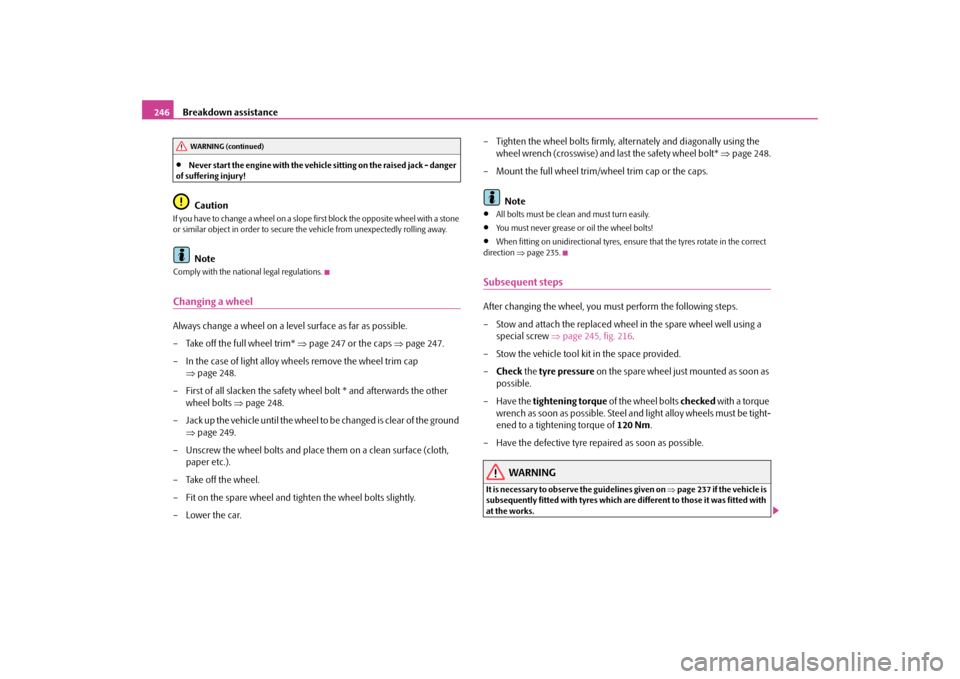
Breakdown assistance
246
•
Never start the engine with the vehicle
sitting on the raised jack - danger
of suffering injury!
Caution
If you have to change a wheel on a slope
first block the opposite wheel with a stone
or similar object in order to secure th
e vehicle from unexpectedly rolling away.
Note
Comply with the national legal regulations.Changing a wheelAlways change a wheel on a level surface as far as possible. – Take off the full wheel trim*
⇒
page 247 or the caps
⇒
page 247.
– In the case of light alloy wheels remove the wheel trim cap
⇒
page 248.
– First of all slacken the safety wh
eel bolt * and afterwards the other
wheel bolts
⇒
page 248.
– Jack up the vehicle until the wheel to
be changed is clear of the ground
⇒
page 249.
– Unscrew the wheel bolts and place them on a clean surface (cloth,
paper etc.).
– Take off the wheel. – Fit on the spare wheel and tighten the wheel bolts slightly. –Lower the car.
– Tighten the wheel bolts firmly, al
ternately and diagonally using the
wheel wrench (crosswise) and last the safety wheel bolt*
⇒
page 248.
– Mount the full wheel trim/w
heel trim cap or the caps.
Note
•
All bolts must be clean
and must turn easily.
•
You must never grease or oil the wheel bolts!
•
When fitting on unidirectional tyres, ensure that the tyres rotate in the correct
direction
⇒page 235.
Subsequent stepsAfter changing the wheel, you must perform the following steps. – Stow and attach the replaced wheel in the spare wheel well using a
special screw
⇒
page 245, fig. 216
.
– Stow the vehicle tool kit in the space provided.–
Check
the
tyre pressure
on the spare wheel just mounted as soon as
possible.
– Have the
tightening torque
of the wheel bolts
checked
with a torque
wrench as soon as possible. Steel and light alloy wheels must be tight-ened to a tightening torque of
120 Nm
.
– Have the defective tyre repaired as soon as possible.
WARNING
It is necessary to observe the guidelines given on
⇒page 237 if the vehicle is
subsequently fitted with tyres which are
different to those it was fitted with
at the works.
WARNING (continued)
s2dk.1.book Page 246 Wednesday, April 8, 2009 12:23 PM
Page 249 of 294
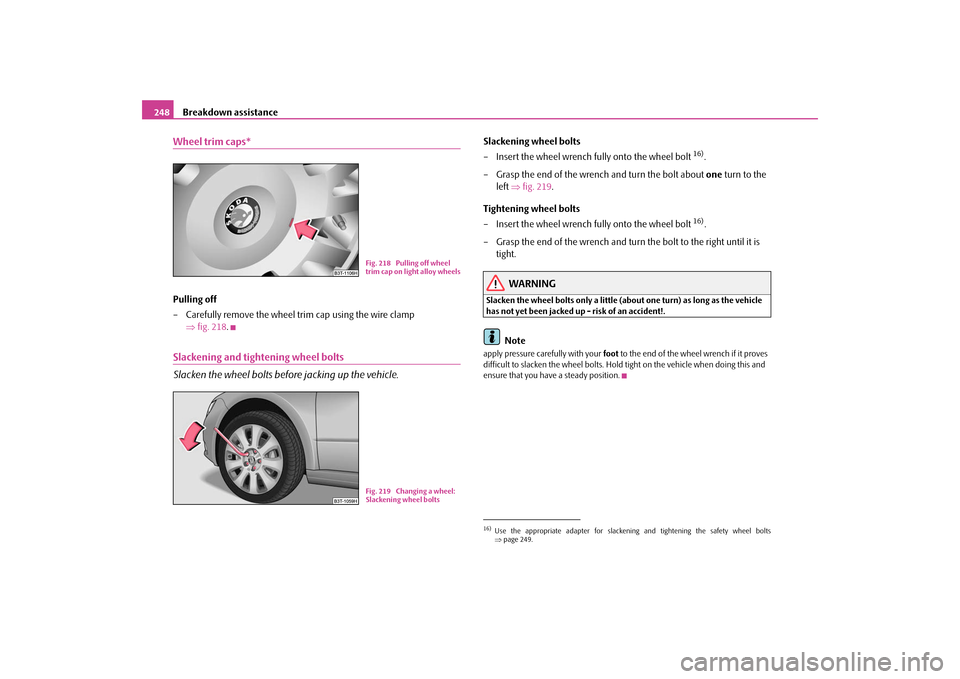
Breakdown assistance
248
Wheel trim caps*Pulling off – Carefully remove the wheel tr
im cap using the wire clamp
⇒
fig. 218
.
Slackening and tightening wheel bolts Slacken the wheel bolts before jacking up the vehicle.
Slackening wheel bolts – Insert the wheel wrench fully onto the wheel bolt
16).
– Grasp the end of the wrench and turn the bolt about
one
turn to the
left
⇒
fig. 219
.
Tightening wheel bolts – Insert the wheel wrench fully onto the wheel bolt
16).
– Grasp the end of the wrench and turn the bolt to the right until it is
tight.
WARNING
Slacken the wheel bolts only a little (a
bout one turn) as long as the vehicle
has not yet been jacked up - risk of an accident!.
Note
apply pressure carefully with your
foot
to the end of the wheel wrench if it proves
difficult to slacken the wheel bolts. Hold tight on the vehicle when doing this and ensure that you have a steady position.
Fig. 218 Pulling off wheel trim cap on light alloy wheelsFig. 219 Changing a wheel: Slackening wheel bolts
16)Use the appropriate adapter for slackening
and tightening the safety wheel bolts
⇒ page 249.
s2dk.1.book Page 248 Wednesday, April 8, 2009 12:23 PM
Page 250 of 294

Breakdown assistance
249
Using the system
Safety
Driving Tips
General Maintenance
Breakdown assistance
Technical Data
Raise vehicle You have to raise the vehicle with a lifting jack in order to be able to take off the wheel. Position the lifting jack by selecting
the jacking point which is closest to
the wheel to be removed
⇒
fig. 220
. The jacking point is located directly
below the engraving in the lower sill. – Position the lifting jack below the jacking point and move it up until its
claw is positioned directly below the vertical web of the lower sill.
– Align the car jack so that its claw grasps the web of the lower sill
and the base plate is resting flat on the floor.
– Turn the lifting jack up further until the wheel is just clear of the
ground.
Ground below the lifting jack which is soft and slippery
can cause the vehicle to
slip off the jack. It is therefore always ne
cessary to place the lifting jack on a solid
surface or use a wide and stable base. Use
a non-slip base (e.g. a rubber foot mat)
if the
surface is smooth
, such as cobbled stones, a tiled floor, etc.
WARNING
•
Always raise the vehicle with the doors closed - risk of injury!
•
Take suitable measures to prevent the base of the lifting jack from slip-
ping off - risk of injury!•
Not positioning the lifting jack at
the specified points can result in
damage to the vehicle. The jack can also sl
ip off if it does not have sufficient
grip - risk of injury!•
It is important to support the vehicle with suitable supporting blocks if
you wish to work under the lifted vehicle - risk of injury!Securing wheels against being stolen* You need a special adapter for slackening the safety wheel bolts.– Pull off the full wheel trim/cap from the wheel hub or cap from the
safety wheel bolt.
– Insert the adapter with its toothed side fully into the inner toothing
of the safety wheel bolt right down in such a way that only the outer hexagon is jutting out
⇒
fig. 221
.
– Insert the wheel wrench fully onto the adapter .– Slacken the wheel bolt, or tighten it firmly
⇒
page 248.
Fig. 220 Changing a wheel: Points for positioning car jac
k
AA
AB
WARNING (continued)
Fig. 221 Safety wheel bolt with adapter
AB
AA
AB
s2dk.1.book Page 249 Wednesday, April 8, 2009 12:23 PM
Page 251 of 294
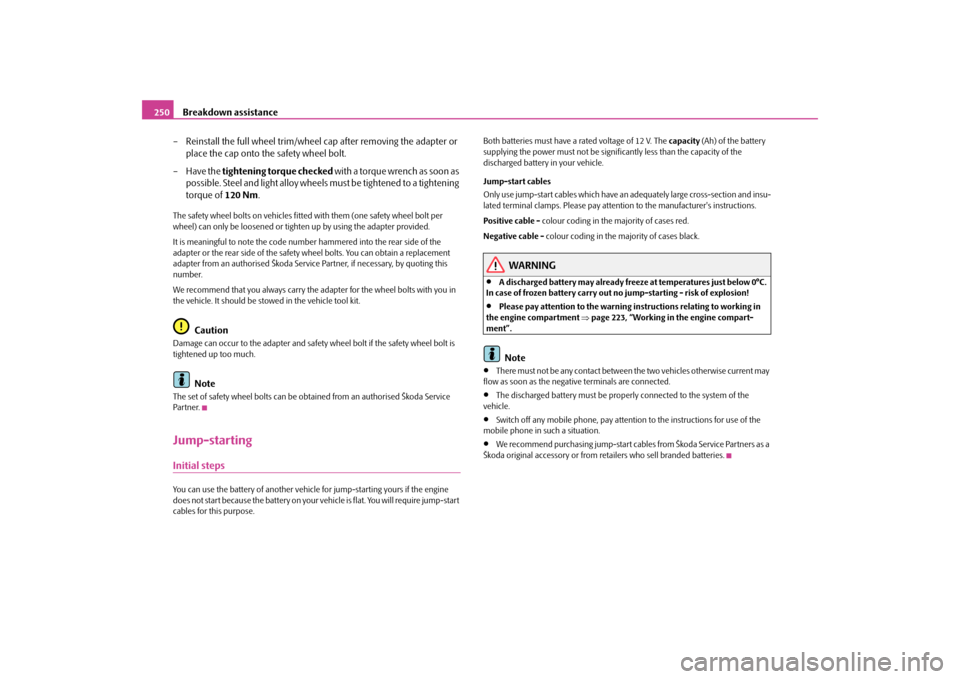
Breakdown assistance
250
– Reinstall the full wheel trim/wheel cap after removing the adapter or
place the cap onto the safety wheel bolt.
– Have the
tightening torque
checked
w i t h a t o rq u e w re n c h a s s o o n a s
possible. Steel and light alloy wheels must be tightened to a tightening torque of
120 Nm
.
The safety wheel bolts on vehicles fitted with them (one safety wheel bolt per wheel) can only be loosened or tigh
ten up by using the adapter provided.
It is meaningful to note the code numbe
r hammered into the rear side of the
adapter or the rear side of the safety wheel bolts. You can obtain a replacement adapter from an authorised Škoda Service Partner, if necessary, by quoting this number. We recommend that you always carry the
adapter for the wheel bolts with you in
the vehicle. It should be st
owed in the vehicle tool kit.
Caution
Damage can occur to the adapter and safety
wheel bolt if the safety wheel bolt is
tightened up too much.
Note
The set of safety wheel bolts can be obta
ined from an authorised Škoda Service
Par tner.Jump-startingInitial stepsYou can use the battery of another vehicl
e for jump-starting yours if the engine
does not start because the battery on your
vehicle is flat. You will require jump-start
cables for this purpose.
Both batteries must have a rated voltage of 12 V. The
capacity
(Ah) of the battery
supplying the power must not be signific
antly less than the capacity of the
discharged battery
in your vehicle.
Jump-start cables Only use jump-start cables which have an
adequately large cross-section and insu-
lated terminal clamps. Please pay attent
ion to the manufacturer's instructions.
Positive cable -
colour coding in the
majority of cases red.
Negative cable -
colour coding in the majority of cases black.
WARNING
•
A discharged battery may already freeze
at temperatures just below 0°C.
In case of frozen battery carry out no jump-starting - risk of explosion!•
Please pay attention to the warning instructions relating to working in
the engine compartment
⇒page 223, “Working in the engine compart-
ment”.
Note
•
There must not be any contact between the two vehicles otherwise current may
flow as soon as the negative terminals are connected.•
The discharged battery must be proper
ly connected to the system of the
vehicle.•
Switch off any mobile phone, pay attent
ion to the instructions for use of the
mobile phone in such a situation.•
We recommend purchasing jump-start cabl
es from Škoda Service Partners as a
Škoda original accessory or from retailers who sell branded batteries.
s2dk.1.book Page 250 Wednesday, April 8, 2009 12:23 PM
Page 252 of 294

Breakdown assistance
251
Using the system
Safety
Driving Tips
General Maintenance
Breakdown assistance
Technical Data
Start engineIt is important to connect the jump
-start cables in the correct order.
Connecting positive terminals – Attach one end to the positive terminal
⇒
fig. 222
of the
discharged battery .
– Attach the other end to the positive terminal of the battery
supplying the power .
Connecting negative term
inal and engine block
– Attach one end to the negative
terminal of the battery supplying
the power .
– Attach the other end to a solid metal part which is connected
firmly to the engine block, or
to the engine block itself.
Starting engine – Start the engine of the vehicle providing current and run the engine at
idling speed.
– Now start the engine of the vehicle with the discharged battery.
– Interrupt the attempt at starting an engine after 10 seconds if it does
not start right away and wait for about 30 seconds before repeating the attempt.
– Disconnect the cables on the engine in exactly the
reverse order
they
were connected up.
WARNING
•
The non-insulated parts of the terminal clamps must never make contact
with each other. Furthermore, the cable connected to the positive terminal of the battery must not come into contact with electrically conducting parts of the vehicle - risk of a short circuit!•
Do not affix the jump starting cables to the negative terminal of the
discharged battery. There is the risk
of detonating gas seeping out the
battery being ignited by the strong
spark which results from the engine
being started.•
Run the jump-start cables so that th
ey cannot be caught
by any rotating
parts in the engine compartment.•
Do not bend over the batteries - risk of caustic burns!
•
The vent screws of the battery cells must be tightened firmly.
•
Keep any sources of ignition (naked
flame, smouldering cigarettes etc.)
away from the battery - risk of an explosion!•
Never jump-start the batteries which have a too low electrolyte level -
risk of explosion and caustic burns!
Fig. 222 Jump-starting using the battery from another vehicle: A - flat vehicle battery, B - battery providing current
A1AAA2AB
A3
AB
A4
s2dk.1.book Page 251 Wednesday, April 8, 2009 12:23 PM
Page 255 of 294

Breakdown assistance
254
Rear towing eye– Press onto the bottom part of the cover in the rear bumper
⇒
fig. 226
and take it out.
– Screw in the towing eye anti
clockwise down to the stop
⇒
fig. 227
and
tighten up using the wheel wrench (push the wheel wrench through eye).
– Put the cover in place after screwing out the towing eye again and
press into place. The co
ver must engage firmly.
Tow-starting a vehicleIf the engine does not start, we generally do
not
recommend
to tow-start
your vehicle. One should attempt to start the engine using jump start cables
⇒
page 250 or call on the services of the SERVICE mobile.
If your vehicle has to be towed – Engage 2nd or 3rd gear wi
th the vehicle stationary.
– Depress the clutch pedal fully and keep it depressed. – Switch on the ignition.– Wait until both vehicles are movi
ng then release the clutch pedal
slowly.
– Depress the clutch pedal fully when the engine fires and take the
vehicle out of gear.
For technical reasons it is not possib
le to tow-start a car fitted with an
automatic
gearbox
.WARNING
There is high risk of having an accident when tow-starting a vehicle, when for example the towed vehicle runs into the towing vehicle.
Caution
Vehicles which are fitted with a catalytic
converter should not be tow-started over
a d i s t a n c e o f m o re t h a n 5 0 m e t re s . U n b u r n
t fuel may get into the catalytic converter
and damage it.Towing in a vehicle fitted with a manual gearboxPlease refer to the notes
⇒page 252.
Fig. 226 Rear bumper: Removing coverFig. 227 Rear bumper: Installing the towing eye
s2dk.1.book Page 254 Wednesday, April 8, 2009 12:23 PM